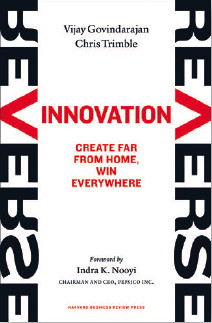
Reverse Innovation: Create Far From Home, Win Everywhere
Vijay Govindarajan & Chris Trimble
256 pages, Harvard Business Review Press
What would you do if you were CEO of General Electric and found out that a company product, a state-of-the-art electrocardiogram developed and manufactured in India, was nowhere to be seen in that country’s rural doctors’ offices? What if you were in a similar position at Procter & Gamble and learned that your feminine care product was being rejected by Mexican women while achieving record-breaking US sales?
The term “reverse innovation” was coined by Dartmouth College business professor Vijay Govindarajan and GE CEO Jeffrey Immelt to describe innovations that go in the opposite direction of what traditionally has been observed. Until recently, innovation seemed to be reserved for industrialized nations. Reverse Innovation, co-authored by Govindarajan and Dartmouth colleague Chris Trimble, digs deep into the work of corporations at the frontier of emerging markets and offers guidance and understanding of this rising phenomenon.
Govindarajan and Trimble could not have timed their book better. Tales of innovation from emerging markets are now reported daily—from Kenya’s mobile banking miracle M-Pesa to Tata Motors’ ultra low-cost Nano. We have transitioned from a time when emerging markets were ignored completely by multinational corporations, to a period when firms turned their attention toward the “bottom billion” as a group of potential consumers, to a new era in which innovation flows from these regions. The authors tell detailed stories that leave you convinced of a rising trend in innovation from this previously ignored market.
At the book’s core are the intricacies and struggles faced by Western firms that were the first to experiment in and successfully enter emerging markets. One example shows how GE realized that the electrocardiograms it was manufacturing were too expensive, were not portable enough, didn’t have batteries, and were too complicated to maintain. After turning the design process upside down, GE eventually produced the MAC400, whose product line has now been deployed in the rest of GE Healthcare markets. (This is a story Govindarajan knows intimately, as he spearheaded GE’s energy and health care innovation efforts from 2008 to 2010.)
The section on Deere & Company is just as captivating, detailing how an organization can learn that its high-quality products may be unsuited for new global markets. Deere’s high-end tractors have, in the authors’ words, “tires taller than an NBA center, loads of high-tech gadgetry, and fully enclosed air-conditioned cabins big enough to have friends in for lunch.” These specs were at odds with the tractors Indian farmers sought: ones that could clock 10 times as many hours and be used to “carry friends and family to the movies, markets, and other social events.” Deere’s team pressed the reset button and successfully applied smart design practices to produce a new utility tractor called Kish for the Indian market—and did so in record time.
Although some of the stories in Reverse Innovation may seem familiar, most were not widely reported and offer far more detail than the usual newspaper article. The book also provides a useful addendum in a “Reverse Innovation Playbook,” which spells out nine rules that enable successful innovation in emerging markets. The playbook is a first of its kind and the closest thing available to a 10 commandments for reverse innovation. Two examples of rules are “To capture growth in emerging markets, you must innovate, not simply export” and “Move people, power, and money to where the growth is—the developing world.” For those hungry for detailed steps to becoming practitioners, the authors also provide a “Reverse Innovation Toolkit.” It is an ideal diagnostic tool for those brave enough to seek out reverse innovation in their own organizations.
Although the book provides compelling evidence of innovation in emerging markets, it leaves one wondering about the role of local firms. The examples in Reverse Innovation are all large Western firms. Is the conclusion that these firms are learning how to interpret and act on the needs of poor consumers? Will innovation be truly reversed only when firms in India, China, or Mexico take the lead in innovation, as has happened with Tata or G-Cash in the Philippines? Maybe it is just a matter of time.
That said, Reverse Innovation is a must read for anyone seeking to participate in emerging markets, be they CEOs of multinationals, leaders of NGOs, or government policy makers.

